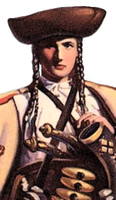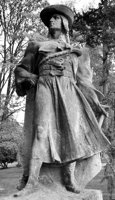
|
The Society of Folk Dance Historians (SFDH)
Janja Jánošík
[
Home |
About |
Encyclopedia | CLICK AN IMAGE TO ENLARGE |

|
BACKGROUND
Information: Janja Jánošík, who became a robber partly to achieve fame and partly to put into practice his theory of despoiling the rich in order to give to the poor
 In bygone days, when the Podhale region in the Tatra Mountains was virtually unknown and quite inaccessible, the very existence of the mountaineers, called "Górals," depended on the bounty of the soil, a crop failure spelling famine and lingering death. Highway and mountain robbery remained the only alternatives for those who did not choose to perish. This selection of profession was in part dictated by the mountaineers' innate courage, their tendency to sudden outbursts of energy, and their love of unrestricted freedom.
In bygone days, when the Podhale region in the Tatra Mountains was virtually unknown and quite inaccessible, the very existence of the mountaineers, called "Górals," depended on the bounty of the soil, a crop failure spelling famine and lingering death. Highway and mountain robbery remained the only alternatives for those who did not choose to perish. This selection of profession was in part dictated by the mountaineers' innate courage, their tendency to sudden outbursts of energy, and their love of unrestricted freedom.
The mountain robbers formed a sort of fraternity, similar to our present day Masonry in the importance it attached to oaths and various rites, in its possession of its own special language and signs, and in its custom of handing down the coveted membership from father to son. The mountaineers did not consider robbery as a dishonorable profession; quite the contrary, the mountain robbers were an esteemed group of society. The Tatra highwaymen were also extremely pious but theirs was a peculiar type of piety. It consisted in worshipping in churches and, in the manner of the Italian banditti, in making votive offerings of the Virgin Mary of Ludzimierz and in devoutly praying for huge booties.
There were degrees of thievery among the Tatra mountaineers. Their code of honor demanded important spoils. No robber would be proud of the theft of a sheep. It had to be at least an ox. The chief booty, however consisted of money and gold.
When the need arose, this booty supported the native settlement of the robber. In the absence of pressing need, the fortune was secreted in the earth for future emergencies. Up to this time, hopeful shepherds searched for these long hidden treasures among the woods and the grottos. Many a respectable homestead was set up with the aid of a pot of ducats dug up from under the roots of an ancient pine tree – a pot of gold placed there centuries ago by the blessed hand of a robber.
 Small wonder that these "cavaliers de bohheur," called "Harnasie," became the symbols of manly virtues and the heroes of innumerable legends. It is impossible to decide to what extent they are historical figures and in what measure they represent the product of the rich fantasy of the mountain folk. Be that as it may, these "Harnasie" are really impressive. Above all is the young and romantic Janja Jánošík, a worthy successor to those mighty predecessors of his, renowned for a strength so potent that it was no unusual feat for him to shatter a mountain or to tear a tree up by its roots. Jánošík is reputed to have worked miracles, being able, for example, to fly over mountain peaks and abysses and to make himself invisible. His great physical power, his agility, and his untamed eagle-like beauty have become legendary.
Small wonder that these "cavaliers de bohheur," called "Harnasie," became the symbols of manly virtues and the heroes of innumerable legends. It is impossible to decide to what extent they are historical figures and in what measure they represent the product of the rich fantasy of the mountain folk. Be that as it may, these "Harnasie" are really impressive. Above all is the young and romantic Janja Jánošík, a worthy successor to those mighty predecessors of his, renowned for a strength so potent that it was no unusual feat for him to shatter a mountain or to tear a tree up by its roots. Jánošík is reputed to have worked miracles, being able, for example, to fly over mountain peaks and abysses and to make himself invisible. His great physical power, his agility, and his untamed eagle-like beauty have become legendary.
Who he was and when he lived, nobody knows. The historical Jánošík is lost in the misty past; and fact, fancy, and wishful imagination are jumbled beyond recognition. But he lives in the traditions and legends of the Polish "Górals;" he is as real as the mountain tornado and the Guardian Angel. Once upon a time there was a Jánošík, a leader of outlaws, a chief of robbers, "a great and good man," a worker of miracles, and giant on earth. He was a common hero to both the Polish mountaineers in the north and to the Czechoslovaks in the south. Whenever an outstanding leader appeared among the "Górals," tradition endowed him with the name and prowess of Jánošík. Such a Jánošík there, was supposed to have been in the days of King Sobieski, and was recreated from "Góral" tradition by poets, writers, and composers.
This "new" Jánošík became a robber partly to achieve fame and partly to put into practice his theory of despoiling the rich in order to give to the poor. Every expedition of his was preceded by lengthy deliberation and by a seeking of inspiration in music and song. Suddenly, he would start off like a hurricane and through the dark and ominous interior of the Tatra mountains would lead his companions on to glorious exploits. Success was climaxed by his dancing and jumping over the fire, in which there was none to equal him.
Jánošík's fabulous wealth permitted him the luxury of building a golden gallows for himself and enabled him to be generous in making gifts to the people of his settlement. He is even reputed to have come to the aid of one of Poland's kings, impoverished through wars. It was he, too, who presented the Empress of Austria with a golden hen and twelve golden eggs to reward her for dancing with him in an inn.
This Polish Robin Hood of the Tatra Mountains, lover of adventure and constant rebel against authority, is half historical and half legendary, not unlike the Robin Hood of Sherwood Forest.
Printed in Rosin the Bow, Volume 2, Number 12, December 1946.
This page © 2018 by Ron Houston.
Please do not copy any part of this page without including this copyright notice.
Please do not copy small portions out of context.
Please do not copy large portions without permission from Ron Houston.